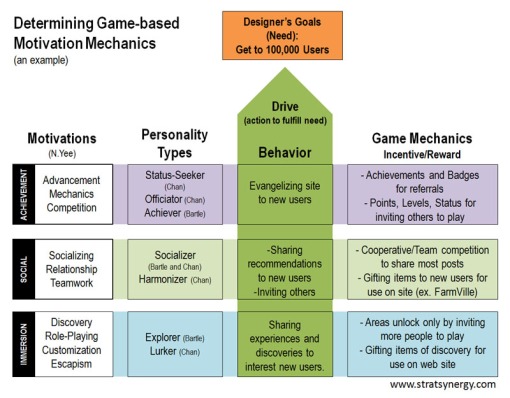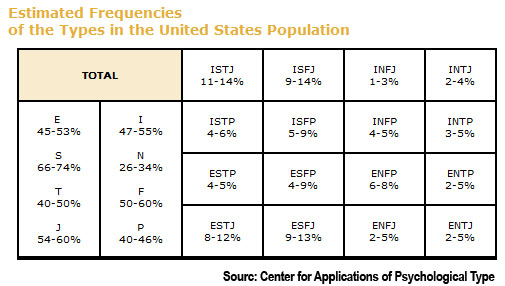Why do game mechanics work?
When designing game mechanics for a particular community, it is important to understand the underlying motivations and personality types that make up that community, otherwise the game mechanics may be ineffective at generating the appropriate user engagement. It all boils down to this: what some people find fun or motivating, others might not.
After defining the site’s goals, the designer’s next step to building a gamified site is to understand the community’s motivations. Attitudes, interests, age, and gender demographics all play a role (as seen in the Motivations and Personality Type sections of this site). Mapping motivations to various personality types allow the designer to select and modify game mechanics to best fit.
Perhaps in this respect it’s better to call them motivation mechanics.
For example, a single goal like increasing users, could be presented in different mechanics, each attractive to different motivations. This chart illustrates the mapping:
Design game mechanics to fit customer motivations:
(Click chart for higher resolution)
Which personality types are found in your web site or game’s community?
When designing game-based applications for a general US population, it may be of interest to examine the frequency of personalities in order to target the broadest reaching gamification strategies. Many personality models are available for study and although each have their own criticisms in scientific approach, it is interesting to look at these reports as a starting basis for design. Ultimately you will want to design, test, and iterate constantly to determine your own customer’s interests.
One of the most established personality models, The Myers-Briggs Type Indicator is termed as “the world’s most widely used personality assessment”. Although the Myers-Briggs model is a general model and not specifically designed for game-based motivations, the types can be generally matched to gaming behaviors.
Myers-Briggs examines the following attributes:
I or E: introverted (I) or extroverted (E) – Derives mental energy primarily from internal (I) or other people (E)
S or N: Sensing (S) or Intuitive (N) – Absorbs information from data/details (S) or by general patterns (N)
T or F: Thinking (T) or Feeling (F) – Decisions based on logic/objective criteria (T) or on emotional intelligence (F)
J or P: Judging (J) or Perceiving (P) – Makes decisions quickly (J) or prefers to take a more casual approach and leaves options open (P)
The Center for Applications of Psychological Type shares estimated frequencies for Myers-Briggs within the United States. A general breakdown is shown here:
The estimated frequency table was compiled from a variety of MBTI® results from 1972 through 2002, including data banks at the Center for Applications of Psychological Type; CPP, Inc; and Stanford Research Institute (SRI).
The complete breakdown by gender is found here.
This CAPT data suggests personality types with the highest frequencies are:
Interestingly, the attributes of Sensing and Judging are found in each of these higher frequency personalities.
Sensing (S) personalities are concerned with what is actual, present, and current, keeping note of facts and remembers details that are important. They favor the practical use of things and believe “experience speaks louder than words”.
The following statements generally apply to Sensing oriented people:
- Remember events as snapshots of what actually happened.
- Solve problems by working through facts until they understand the problem.
- Pragmatic and look to the “bottom line.”
- Start with facts and then form a big picture.
- Trust experience first and trust words and symbols less.
- Sometimes pay so much attention to facts, either present or past, that they miss new possibilities.
Judging (J) personalities have a preference to decision-making (Thinking or Feeling) in their outer life. Their public preference is to planned or orderly ways of life. Judging personalities like to have things settled and organized, feeling more comfortable when decisions are made.
(Note: Do not confuse Judging with judgmental, in its negative sense about people and events. They are not related.)
The following statements generally apply to Judging-oriented people:
- Prefers to have things decided.
- Appear to be task oriented.
- Likes lists of things to do.
- Like to get work done before playing.
- Plan work to avoid rushing just before a deadline.
- Sometimes focuses so much on the goal that they miss new information.
(Source: Myers-Briggs Foundation)
Most successful games (whether social/mutli-player or single player) have user experiences built upon these attributes and they can provide a foundational structure to add complimentary experiences and mechanics to. From FarmVille’s crop management to Foursquare’s achievements to World of Warcraft’s quests, most people will find these logistical structures and goals attractive.
David Keirsey defines this S-J temperament as Guardian (Logistical). Logistical games, involving the management of flow of goods, information and other resources between one point and other, are further explored in Chris Bateman’s book 21st Century Game Design. A logistical game offers rewards by allowing players a facility to organize and optimize components while they meet needs of particular tasks.
How can a logistical design be implemented in terms of gamification? By offering interesting choices for players to manage decisions and achieve within the system, offering an extensive selection of upgrades or virtual items, and a method to convert a player’s time, effort, skill, or real world money into in-game resources.
However, as we have covered in previous posts, achievements are not the be-all and end-all of game design. Adding diversity in mechanics can maximize coverage and participation. One of the reasons why Blizzard’s World of Warcraft is able to thoroughly engage it’s 11 million player community is the game’s ability to tap into a plethora of motivations. Whether the user is interested in Player vs. Player (PvP), socializing, team-based cooperative play, strategy, role playing or achievements, there is a facet in this MMO system for everyone.
It is important to note, however, that your community’s psychographics may differ from the general population. For example, a group that includes predominantly ”hardcore PvP gamers” may be more predisposed to power or manipulative sensation-based motivations, whereas a “casual gamer” may be interested in building relationships or logical rule-discovery challenges.
Iterative and incremental testing/development with frequent communication with your users will help tune your game-based designs.
Gamification Blog posts related to this subject:
The Myth of the Universal Player
Why Both Intrinsic and Extrinsic Motivation Matter in Gamification
Gamification, Reality TV and Reiss’s 16 Intrinsic Motivators







